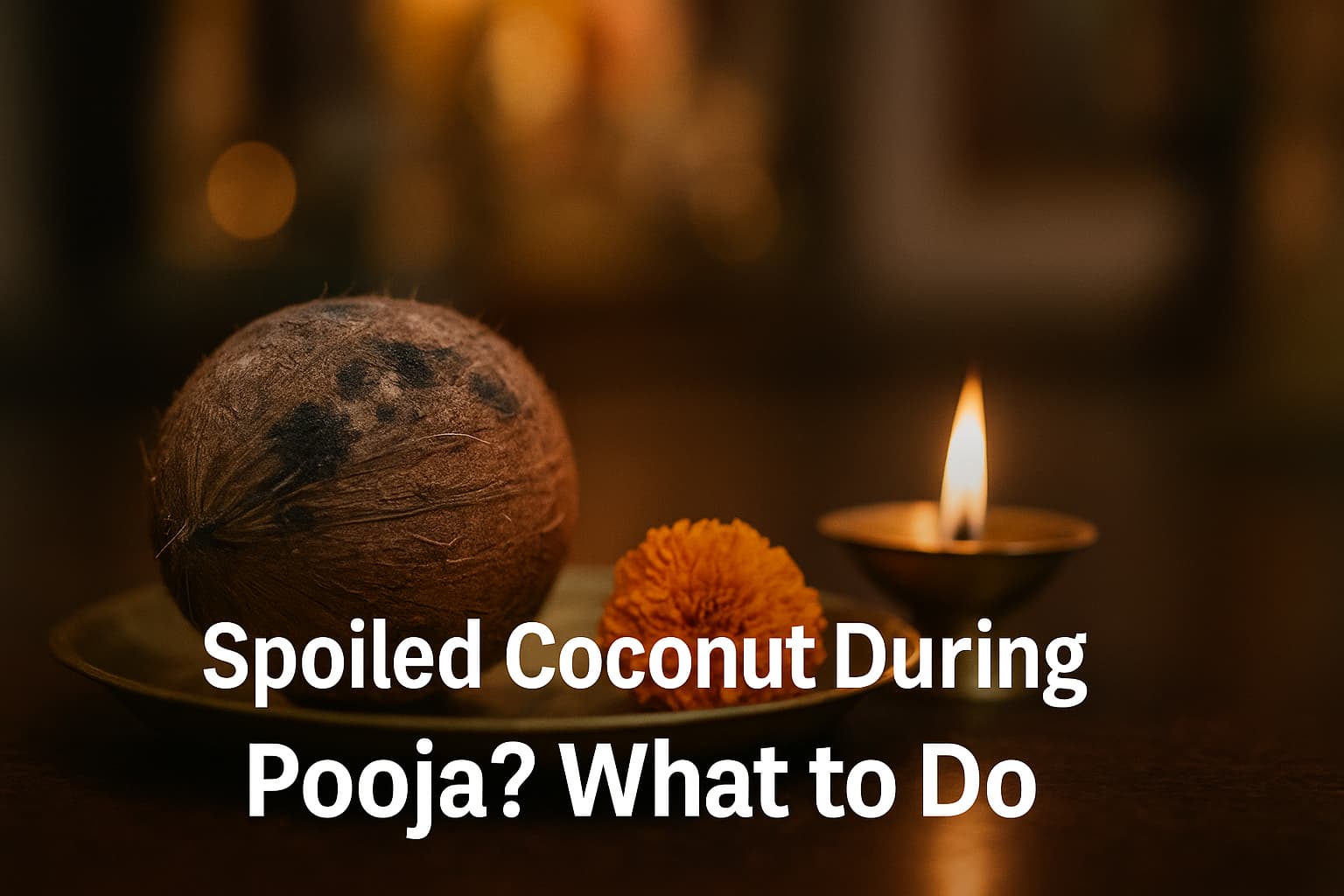Spoiled Coconut During Pooja: Meaning, Priest Guidance & Safe Disposal
spoiled coconut during pooja meaning—what should a devotee understand if the coconut smells sour, has discolored water, or shows mold when opened? This guide gives a calm, tradition-based view: how temples usually handle it, what the priest may suggest, and the respectful way to dispose and replace the coconut. No fear or superstition—just clear etiquette, simple safety, and practical next steps so your worship can continue peacefully.
What a Spoiled Coconut Means: Not a Bad Omen
A spoiled coconut during pooja is not a sign of divine anger or a rejected prayer. In most traditions it simply means the fruit wasn’t fresh or got naturally compromised (age, heat, storage). It’s a practical issue with the item—not a spiritual judgment on you or your devotion. Inform the priest, replace it with a fresh coconut, and continue worship calmly.
- Your sincerity is what counts.
- The prayer is still valid.
- It’s a nudge to offer a fresh, pure item.
What to Do
Found the coconut spoiled? Keep it simple—handle it calmly, inform the priest, and replace it. Follow these quick steps.
- Pause, don’t panic: Set the coconut aside; avoid spillage on the floor or near the sanctum.
- Inform the priest (archaka): Let them check and advise whether to proceed or replace immediately.
- Replace with a fresh coconut: Get a new, clean fruit as instructed and continue your sankalpa.
- Dispose respectfully: Use the temple-designated bin/spot. If at home, wrap and place in organic waste; do not throw in drains.
- Cleanliness & hygiene: Wipe the area if any liquid spilled; wash hands before resuming worship.
- Continue calmly: Offer thanks, keep the space tidy, and complete the pooja without hurry.
Do
- Follow the priest’s instruction as final.
- Use a fresh, heavy coconut for the repeat.
- Keep the platform clean for others.
Don’t
- Debate meanings loudly or create a crowd.
- Consume rancid/moldy coconut or water.
- Leave fragments or liquid on the floor.
Why a Coconut Might Spoil (Natural, Not Supernatural)
Coconuts are natural products. Spoilage happens for practical reasons—think heat, storage, age, or transport—not as a spiritual judgment.
Natural Causes
High heat, poor ventilation, long storage, or rough transport can dry out the water, invite mold, or hairline-crack the shell and let microbes in.
The “Sound Test”
Before buying, gently shake the coconut. A clear sloshing sound suggests fresh water inside; a very flat or dull sound can mean it’s dried out or spoiled.
Visual Clues
Look for black/yellow mold patches, a leaky or soft “eye,” or sour/fermented smell. These signals mean: don’t use it—choose a fresh one.
- Pick heavier coconuts for their size; weight often means more fresh water.
- Prefer shells without cracks; avoid sticky or damp eye regions.
- Store in a cool, airy place before the offering; avoid direct sun in vehicles.
Conclusion & Related Content
A spoiled coconut isn’t a bad sign—it’s simply a chance to renew your offering.
The strength of the ritual comes from your sincerity, not the condition of the fruit.
Calmly replace it with a fresh coconut and continue your pooja without worry.
Keep the space clean and handle fragments respectfully as prasada or as directed.
Always follow the temple priest’s guidance; their instruction is the final word.
In doing so, you honor your sankalpa and keep the moment sacred.
Coconut Splits into 3 Pieces
Horizontal vs vertical meaning, simple etiquette, and next steps.
Idagunji: Coconut Offering — Symbolism
What the offering represents and how to do it respectfully.
Top 10 Biggest Jatre in Karnataka
Major fairs, what to expect, and tips for a smooth visit.
Kala Bhairava Temples in Karnataka
Notable shrines, worship insights, and visiting guidance.

